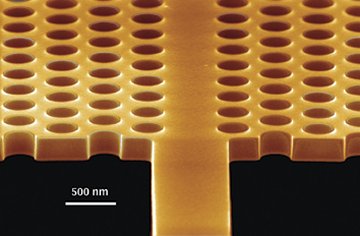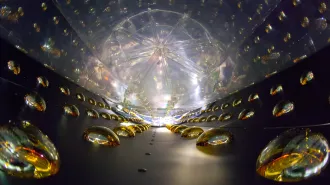Just as optical fibers have replaced most electrical wires for long-distance telecommunications, light-based circuits may replace electrical ones in applications involving vast flows of data within computers and networks. Now, a team of industrial researchers has taken what may be a crucial step toward such photonic circuitry: They’ve found a way to dial down the speed of light within microchip components.

Because any photonic circuit must store information temporarily, scientists have in recent years developed numerous ways to slow light pulses, effectively holding on to them for brief periods of time. In the new work, Yurii A. Vlasov and his colleagues at IBM T.J. Watson Research Center in Yorktown Heights, N.Y., have demonstrated on-chip control of the duration of those delays.
Future photonic computers or other circuitry will need such controls to choreograph light pulses in much the same way as automobile drivers apply their brakes in order to merge, turn, and synchronize with other vehicles.
“Being able to tune and control the retardation opens whole new avenues for manipulating light on a chip,” comments Laurens Kuipers of the FOM Institute for Atomic and Molecular Physics in Amsterdam.
Unhindered, light tools along at 300,000 kilometers per second (kps). Six years ago, physicists demonstrated the ability to slow light to a full stop using clouds of specially prepared atoms (SN: 3/27/99, p. 207: References and sources available at http://www.sciencenews.org/pages/sn_arc99/3_27_99/note8ref.htm). Since then, other scientists have shown that light can be slowed—although not stopped—by means of a microchip component called a photonic crystal (SN: 10/4/03, p. 218: Hot Crystal). That technology lends itself to practical applications because it relies on silicon processed by standard manufacturing methods.
Vlasov and his colleagues have added another level of control to on-chip light slowing. Using a photonic crystal—in this case, a sliver of silicon punctuated by tiny holes—they have slowed light down to as little as 1,000 kps. The drop in light speed enables the component to retard pulses long enough to store a few bits of data in a network operating at 10 billion bits per second, a common data-handling rate for today’s systems.
Moreover, the IBM team has added what’s in essence a brake pedal: By placing electrodes of a nickel-silicon alloy on each side of the photonic crystal, the team provided a means to send small currents through the silicon. Those flows heat the crystal, altering the amount of delay that passing light pulses undergo. The IBM team describes its new device in the Nov. 3 Nature.
“The ability to actively and rapidly tune the delay is very important and is one of the hardest parts” of creating light-storage components, says John R. Lowell, who heads a program of the Defense Advanced Research Projects Agency (DARPA) in Arlington, Va., that has funded the IBM work. “They’ve tackled [that part] in a very novel way,” he adds.
DARPA has also funded efforts to find other ways to slow and store light in chips and optical fibers.







